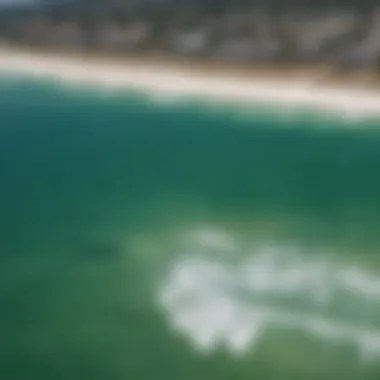Exploring Local Weather Trends for Kiteboarding in Fort Walton Beach


Intro
Fort Walton Beach, located on the picturesque Emerald Coast of Florida, is well-known for its stunning vistas and vibrant outdoor culture. Among the various activities that draw enthusiasts to this coastal haven, kiteboarding stands out as a thrilling pursuit, skillfully combining elements of both surfing and flying. The weather plays a pivotal role in shaping the kiteboarding experience, directly influencing riding conditions, visibility, and safety.
Understanding local weather patterns is essential for ensuring enjoyable and safe kiteboarding sessions. By examining the seasonal variations, climate influences, and specific weather phenomena, it becomes evident how crucial this knowledge is for both novice and seasoned kiteboarders alike.
In this article, we will explore the nuances of weather in Fort Walton Beach, including gear necessities and expert tips for kiteboarders. With information derived from historical climate data and insights into current trends, this comprehensive guide aims to equip outdoor enthusiasts with everything they need to make informed decisions when planning kiteboarding adventures.
Gear and Equipment
When it comes to kiteboarding, having the right gear can make a world of difference. From beginners still learning the ropes to experienced riders pushing the limits, understanding essential equipment is key.
Essential Kiteboarding Gear for Beginners
- Kite: The heart of kiteboarding, a good-quality kite is crucial. For those just starting out, a beginner-friendly kite that is stable and easy to control is a must.
- Board: This is your platform on the water. Beginners should opt for a board that offers more surface area for better buoyancy, making it easier to get started.
- Harness: A comfortable harness that fits well will distribute the pull of the kite evenly across your body, minimizing fatigue.
- Safety Gear: Don’t skimp on a helmet and flotation vest. Safety is paramount, especially in unpredictable weather.
Advanced Equipment for Experienced Riders
As riders progress, upgrading equipment can enhance performance. Here are some essentials for those looking to level up:
- High-Performance Kite: Riders can explore different types of kites like Freestyle, Wave, or All-around, tailored to their specific riding styles.
- Specialized Boards: Choosing a board designed for specific conditions can greatly enhance performance, whether it’s a light-wind board or one tailored for high-speed tricks.
- Bar and Lines: Upgraded bars with better grip and lines that minimize drag can make a significant difference in control and maneuverability.
- Accessories: Items such as impact vests, booties, and wetsuits specific to seasonal variations in Fort Walton Beach enhance protection and comfort.
"Understanding the local weather is not just an advantage for performance, but a necessity for safety on the water."
Techniques and Tips
No amount of gear can substitute for skill. Improving your kiteboarding techniques ensures a more enjoyable experience out on the water, and there are plenty of tips to consider.
Basic Riding Techniques for Newbies
- Body Position: Keeping your body low and centered over the board will provide better control and stability, particularly in gusty winds.
- Edge Control: Practice controlling your edge; leaning back helps in cutting through the water smoothly.
- Kite Control: Learning to steer the kite accurately will be crucial. Use small, deliberate movements to manage the power.
Expert Tricks to Elevate Your Skills
Once you've mastered the basics, here's how you can take your skills up a notch:
- Jumping Techniques: Focus on timing your jumps and kite control to soar higher. Use the wind to your advantage, learning to harness gusts.
- Tricks: Progress towards simple tricks like spins or grabs. Consistent practice allows you to build a repertoire.
- Reading the Wind: Understanding shifts in wind patterns can help in predicting conditions better, leading to improved performance and reduced risks.
- Join a Community: Engaging with other kiteboarders helps in sharing insights about local spots and conditions, offering mutual support in refining skills.
As kiteboarding has a strong connection to the weather, understanding what to expect can significantly contribute to safety and enjoyment while riding.
In the sections that follow, we will delve deeper into the seasonal weather patterns of Fort Walton Beach, discussing how they affect kiteboarding conditions and providing valuable resources for local weather monitoring.
Understanding the Climate of Fort Walton Beach
Understanding the climate of Fort Walton Beach is a cornerstone for anyone who seeks to enjoy its outdoor offerings, particularly kiteboarding. Weather patterns play a pivotal role in shaping conditions that can make or break a kiteboarding experience. Kiteboarders, outdoor enthusiasts, and travel bloggers benefit from being in the know about what Mother Nature has in store. By grasping the local weather nuances, enthusiasts can better plan their outings, ensuring both safety and enjoyment.


The significance of this understanding goes beyond mere temperature and precipitation levels. It interfaces with crucial elements like wind patterns, humidity, and seasonal variations that define the kiteboarding season. A kiteboarder who understands these factors is better equipped to harness favorable winds and avoid treacherous conditions.
In essence, understanding the climate offers not just a pathway to better kiteboarding experiences, but also enhances overall enjoyment of the beautiful Fort Walton Beach area.
Climate Classification
Fort Walton Beach falls under the humid subtropical climate classification. This means that the area experiences hot summers and mild winters, characteristics that attract outdoor enthusiasts year-round. Unpacking this classification gives us insights into how weather behaves throughout the year.
- Summer (June to September): Expect sweltering heat with temperatures often climbing above 90°F (32°C). Alongside, there are also summer thunderstorms; knowing when to expect them can help kiteboarders plan their sessions.
- Winter (December to February): On the flip side, winters are mild, with daytime highs averaging around 60°F to 70°F (15°C to 21°C). While it can get chilly, it rarely dips below freezing, making it a suitable time for kitesurfing, provided the winds cooperate.
In addition to temperature, understanding rainfall patterns is crucial. For instance, the region sees its most intense rain during the summer months, primarily due to tropical systems. Kiteboarders and travelers should be aware of this, especially when planning outdoor activities.
Geographical Influences
The geographical layout of Fort Walton Beach contributes significantly to its unique climate. Surrounded by water, the Gulf of Mexico creates a moderating effect on temperature, leading to milder weather conditions compared to areas further inland.
- Proximity to the Gulf: The ocean influences local weather patterns. The prevailing easterly winds from the Gulf often create ideal kiteboarding conditions, especially during spring and summer when the wind tends to be more consistent.
- Elevation and Terrain: Although the elevation in Fort Walton Beach itself is fairly low, the absence of tall mountains means that wind can flow freely. This is a boon for kiteboarders. However, it also means that sudden changes in weather can occur, calling for awareness and preparedness.
- Influence of Land Features: The coastal dunes and marshlands can affect localized wind flow. Understanding these features can provide kiteboarders with insights on where best to ride based on wind conditions.
Being informed about these geographical factors allows kiteboarders to exploit their surroundings fully. By combining knowledge of the local climate classification with geographical influences, enthusiasts can tailor their outings to suit prevailing conditions, thus maximizing their enjoyment and safety on the water.
"Knowledge of local climate isn’t just nice; it’s essential for thriving in the sport of kiteboarding."
Integration of these insights results in improved kiteboarding sessions, safer activities, and a far richer interaction with Fort Walton Beach's natural offerings.
Monthly Weather Overview
Understanding the monthly weather patterns in Fort Walton Beach is essential for anyone who enjoys outdoor activities, especially kiteboarding. Weather conditions can dramatically affect the safety and enjoyment of riding the waves. By closely examining the shifts from one month to the next, kiteboarders can better prepare for their excursions. This section highlights the specifics of the weather in Fort Walton Beach month by month, offering insights on how to navigate the conditions throughout the year.
January Weather Patterns
January in Fort Walton Beach sees cooler temperatures, typically ranging from the low 40s to mid-60s Fahrenheit. While kiteboarding may not be rampant, winds are often consistent at about 10 to 15 miles per hour. This month also brings increased precipitation, leading to occasional cold fronts. Kiteboarders should be aware that while the winds are favorable for some light riding, temperatures can dip surprisingly low, necessitating proper gear to remain comfortable.
February to April Conditions
As the second month of the year rolls in, the weather starts warming up. February's temperatures generally hover between the mid-40s and high-60s, and by March, the range jumps into the 50s through 70s. Winds remain favorable during this period, often providing almost perfect conditions for kiteboarders. April usually witnesses the peak of spring weather, with temperatures going up into the high 70s. Frequent sunny days contribute to the ideal wind conditions for kiteboarding enthusiasts eager to hit the water.
Summer Weather Insights
The summer months showcase Fort Walton Beach at its most vibrant. June through August typically showcases high humidity and temperatures frequently hitting the mid-90s. Despite the muggy conditions, afternoon thunderstorms can pop up, although morning winds can often be ideal for kiteboarding. Typical wind speeds might range from 12 to 20 miles per hour, providing great conditions for experienced riders. Still, kiteboarders must exercise caution, ensuring to check radar and forecasts regularly.
Fall Transition
As summer fades, Fort Walton Beach transitions into fall, a time for kiteboarders to prepare for shifting conditions. September and October bring about a notable change with temperatures cooling down, but winds can still be favorable, averaging between 12 to 18 miles per hour. The humidity also decreases, making it more comfortable to ride longer stretches. However, with fall comes hurricane season, putting everyone on alert for severe weather conditions. Kiteboarders should be on guard and monitor local forecasts closely during this time to avoid dangerous situations.
Impact of Seasonal Changes on Kiteboarding


Understanding how seasonal changes impact kiteboarding is crucial for enthusiasts aiming to capitalize on Fort Walton Beach’s distinct weather patterns. Each season brings varying wind and temperature conditions that can either enhance or hinder performance. Kiteboarders, whether beginners or pros, need to grasp these dynamics to schedule their outings effectively and ensure safety on the water.
Wind Patterns and Kiteboarding
In Fort Walton Beach, wind patterns play a pivotal role in kiteboarding success. Typically, spring and summer seasons table certain favorable wind conditions that are appealing to kiteboarders. From March to September, the predominant southeast winds create consistent conditions ideal for riding. This period often features trade winds that whistle through the palm trees, offering the kind of breezes that make kiteboarding exhilarating.
However, shifts can occur. A sudden storm front can transform the landscape, shifting winds to unpredictable gusts. Kiteboarders need to be aware of local weather forecasts and conditions just before heading out. Checking wind speed on trusted sites can pay off big. Some enthusiasts swear by local weather stations while others rely on apps that give live updates.
"Knowing the wind direction is half the battle. You can’t just go kiteboarding; you must dance with the wind."
Even the direction of the wind matters. South winds can jam up against the land, sometimes reflected back towards the ocean, creating confused and choppy waves. Conversely, northeast winds can offer smooth sailing with a reliable uplift. Staying informed about these nuances can close the gap between a mediocre session and an unforgettable one.
Temperature Effects on Performance
Temperature is another significant factor when kiteboarding in Fort Walton Beach. The breezy, humid summers can feel sweltering, pushing temperatures to the upper 90s. While hot air increases lift, it can also lead to fatigue and hinder performance. Kiteboarders might find it challenging to stay hydrated while pushing through longer sessions under the scorching sun.
Winter, though milder, has its quirks too. Colder air can impact the performance of the kites and gear. One might notice a difference in how the kite responds in lower temperatures compared to the warm, buoyant air of summer. Optimal conditions tend to hover around those balmy temperatures—higher than 60°F but not scorching.
To strike the right balance, kiteboarders often choose to ride either early in the morning or later in the afternoon. During these times, temperatures are less intense, and the winds remain steady, creating a cocktail of ideal conditions for a chronic ride across the sparkling waters.
In summary, kiteboarders in Fort Walton Beach must pay close attention to the seasonal shifts in both wind and temperature. By understanding these essential components, they can better prepare themselves for an exhilarating experience on the water. Adaptability is key; knowing when to kiteboard could lead to impressive improvements in skill and, ultimately, enjoyment.
Weather Forecasting Techniques
Understanding the various weather forecasting techniques is crucial for anyone interested in kiteboarding in Fort Walton Beach. The right forecast allows kiteboarders to choose their riding days wisely, optimizing enjoyment and safety. Accurate forecasts can help predict not just the day-to-day weather, but also any changes in conditions that might affect water sports activities. Whether you’re a seasoned pro or a beginner eager to make the most of your time on the water, being in-the-know is your best bet.
Current Forecasting Tools
There are several tools available for kiteboarders in Fort Walton Beach that can greatly aid in planning their days on the water. Let’s look at a few of the most popular:
- Smartphone Apps: Applications like Windy and SailFlow provide up-to-the-minute updates on wind speeds and directions, temperature, and tides. Users can even set custom alerts for wind conditions that suit their riding style.
- Local Weather Stations: Community-run weather stations are popping up everywhere. These often provide hyper-local forecasts that can be more reliable than larger national services. They can offer minute-by-minute updates on changing conditions.
- Web Dashboards: Websites such as NOAA's National Weather Service provide detailed reports including radar images and forecast models. The benefit here is the professional standard of data, which can be trusted during planning.
Combining multiple sources of information, like using a weather app along with checking local forecasts, adds another layer of reliability. Having the multiple perspectives ensures that one is not flying blind.
"Weather isn’t just a small talk topic; it influences every outdoor activity. For kiteboarders, it’s a game changer."
Long-term Weather Predictions
Long-term weather predictions hold particular significance for kiteboarding enthusiasts planning trips or events. While short-term forecasts might focus on daily conditions, long-term predictions can shed light on seasonal shifts that can impact kiteboarding:
- Seasonal Averages: Understanding the typical weather for each season allows kiteboarders to anticipate the best months for their sport. For instance, spring often brings consistent winds, ideal for both learning and advanced kiteboarding.
- Annual Trends: Over the years, gathering data on how weather has shifted—be it an increase in storm frequency or changes in wind patterns—can inform better future planning.
- Climate Models: Tools like the Climate Prediction Center offer projections based on historical and current data. They can show trends that might suggest upcoming weather patterns over the months ahead. This can be essential for kiteboarding schools looking to attract clients at peak times.
By keeping an eye on long-term patterns, kiteboarding enthusiasts can make educated choices that maximize their enjoyment, ensuring that they catch the right winds and avoid potential hazards.
Local Resources for Weather Monitoring


Monitoring local weather in Fort Walton Beach is crucial, especially for kiteboarding enthusiasts who rely on accurate information to make safe and enjoyable decisions. When winds pick up or a storm brews, having access to the right resources can mean the difference between a thrilling ride and a dangerous situation. From community-based weather stations to sophisticated online portals, there's a wealth of information at the fingertips of those who know where to look.
Community Weather Stations
Community weather stations serve as grassroots initiatives that deliver real-time data pertinent to local weather conditions. These setups are often managed by local citizens or groups who are passionate about meteorology and the outdoors.
- Localized Data: Unlike broader forecasts, community weather stations provide hyper-localized data reflecting specific conditions in Fort Walton Beach. Temperature fluctuations, barometric pressure changes, and wind speeds can vary dramatically even within a small area, so this localized perspective is invaluable.
- Accessibility: Many community weather stations publish their results online or through various social media platforms. This accessibility allows anyone, including kiteboarders, to tap into current conditions. Websites like Facebook often have pages dedicated to local weather monitoring, where real-time updates can be found.
- Engagement: Participating in community weather initiatives can also create a sense of belonging. Many of these stations welcome input from the public, encouraging individuals to share their observations, thus building a collaborative weather community.
Online Weather Portals
Online weather portals have become a cornerstone for gathering extensive, real-time weather information. These websites aggregate data from various sources, giving kiteboarders comprehensive insights into upcoming conditions.
- Diverse Sources: Sites like Reddit host forums where locals and weather enthusiasts share insights about the weather in Fort Walton Beach. These communities discuss everything from sudden wind changes to seasonal trends, offering a rich tapestry of information.
- Forecasting Tools: Many online platforms offer forecasting models and radar systems that can visualize upcoming weather patterns. These tools can be particularly handy when planning a kiteboarding trip, helping individuals scope out the best riding days based on reliable predictions.
- Mobile Accessibility: With smartphone apps becoming increasingly popular, accessing weather data on-the-go is easier than ever. Applications from established sources like the National Weather Service or local stations can offer updates right in your pocket, keeping kiteboarders informed while they are at the beach.
"The weather can change in the blink of an eye. Monitoring local conditions through reliable resources is essential for safety and enjoyment."
Safety Considerations in Local Weather
When it comes to engaging in outdoor activities like kiteboarding, understanding the local weather is like having the secret sauce for a perfect recipe. Safety considerations are not just an afterthought; they are paramount to enjoying the thrill of the ride while ensuring a secure environment. As we delve deeper into Fort Walton Beach's unpredictable elements, it'll become clear why kiteboarders must prioritize safety in their sport.
In Fort Walton Beach, the interplay of seasonal changes can introduce a host of unique weather patterns that dramatically affect kiteboarding conditions. Sudden shifts in wind strength can alter the dynamics of the waves, and the presence of storms can pose serious risks. This landscape of weather phenomenons highlights the need for kiteboarders and outdoor enthusiasts alike to be informed and prepared.
Identifying Severe Weather Conditions
Severe weather can strike without warning, making it essential for kiteboarders to be vigilant about the signals of impending conditions. Darkening clouds gathering on the horizon, for instance, often hint at a storm, and ignoring these signs can lead to dire consequences. Here are some indicators that kiteboarders should keep an eye on:
- Rapid Temperature Changes: A sudden drop in temperature can indicate a cold front, often accompanied by strong winds or storms.
- Increased Wind Activity: If winds unexpectedly spike or shift direction, especially if they become erratic, it could spell trouble.
- Cloud Patterns: Familiarity with different types of clouds—like cumulonimbus, which typically suggests severe thunderstorms—can help predict adverse weather.
- Weather Radars and Apps: Utilizing tools like weather radars, available through companies such as NOAA or local meteorological services, proves invaluable in gauging real-time weather changes.
"Always trust your instincts; if it doesn’t feel right, it probably isn’t!"
Regardless of experience level, kiteboarders should make it a routine to check forecast updates and local weather advisories before hitting the water. Recognizing severe conditions early can make all the difference between a thrilling session and a dangerous situation.
Emergency Preparedness for Kiteboarders
Preparation is everything. Kiteboarding can be exhilarating, but it also exposes riders to possible emergencies due to rapidly changing weather conditions. Developing an emergency plan could very well save lives. Consider these foundational aspects of preparedness:
- Create a Safety Checklist: Prior to each outing, ensure you have your gear checked, including emergency flotation devices and signaling devices like whistles or flares.
- Know Your Exits: Be aware of the nearest points onshore where you can seek safety. Remember, a quick getaway may be necessary if conditions deteriorate.
- Establish Communication Protocols: Always inform someone about your plans—where you’re going, what time you expect to return, and any alternate routes.
- Familiarize Yourself with Rescue Procedures: Understanding how to assist yourself and others in case of a capsize or other mishap is crucial. If you're unsure, consider taking a safety course.
- Keep an Emergency Kit Handy: Essentials to consider including are a first aid kit, water, snacks, a flashlight, and a waterproof communication device. While packed in your gear bag, these items become lifelines in unexpected situations.
The End: Weather as a Key Element for Kiteboarding Success
Understanding local weather patterns is crucial for kiteboarding aficionados venturing into the waters of Fort Walton Beach. Kiteboarding is an exhilarating sport, but it demands not only skill and equipment but also a keen awareness of the environment. The wind, water conditions, and temperature all play significant roles in determining the safety and enjoyment of each ride.
A kiteboarder's success is intricately tied to these weather elements. For instance, the strength and direction of the wind can dictate which kite is appropriate for a given session. Wind conditions in Fort Walton Beach often vary widely throughout the year, making it essential to choose the right time for riding. Familiarizing oneself with seasonal variations in wind patterns allows enthusiasts to maximize their time on the water between gusty afternoons in the summer and quieter breezes in the fall and winter.
Additionally, temperature influences comfort and performance. On hot summer days, the warmth can be inviting, yet extreme heat can lead to fatigue. Thus, timing your sessions during cooler hours might enhance endurance and enjoyment. Cold water temperatures during the winter months may require wet suits, adding another layer of preparation needed for a successful outing.
In terms of safety, the ability to recognize severe weather conditions is paramount. Knowledge about storm patterns and lightning activity can prevent unfortunate incidents while kiteboarding. Keeping informed through local weather forecasts and community resources ensures that kiteboarders can avoid dangerous situations.
"To kiteboard is to dance with the wind; knowing its rhythm can spell the difference between a joyful glide and an unwanted tumble."
As kiteboarders often share their experiences and tips online, following discussions in communities on platforms like Reddit or Facebook can provide insights into current conditions and expert advice.
Emphasizing the relevance of weather as a pivotal aspect of kiteboarding also allows enthusiasts to foster a community based on knowledge-sharing. With a supportive network, kiteboarders can learn from each other’s experiences and weather stories, enhancing their overall riding adventures.















